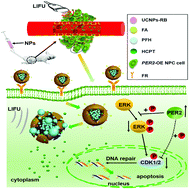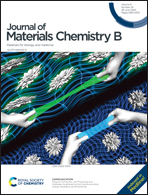The circadian clock gene PER2 enhances chemotherapeutic efficacy in nasopharyngeal carcinoma when combined with a targeted nanosystem†
Abstract
Treatment failure occurs in more than 40% of advanced nasopharyngeal carcinoma (NPC) patients including local recurrence and distant metastasis due to chemoradioresistance. Circadian clock genes were identified as regulating cancer progression and chemoradiosensitivity in a time-dependent manner. A novel nanosystem can ensure the accumulation and controllable release of chemotherapeutic agents at the tumour site at a set time. In this study, we investigated the expression of circadian clock genes and identified that period circadian regulator 2 (PER2) as a tumour suppressor plays a key role in NPC progression. A label-free proteomic approach showed that PER2 overexpression can inhibit the ERK/MAPK pathway. The chemotherapeutic effect of PER2 overexpression was assessed in NPC together with the nanosystem comprising folic acid (FA), upconverting nanoparticles covalently coupled with Rose Bengal (UCNPs-RB), 10-hydroxycamptothecin (HCPT) and lipid-perfluorohexane (PFH) (FURH-PFH-NPs). PER2 overexpression combined with the targeted and controlled release of nanoagents elevated chemotherapeutic efficacy in NPC, which has potential application value for the chronotherapy of tumours.



 Please wait while we load your content...
Please wait while we load your content...